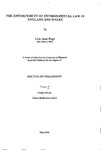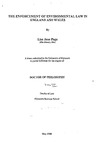THE ENFORCEMENT OF ENVIRONMENTAL LAW IN ENGLAND AND WALES
| dc.contributor.author | Page, Lisa Jane | |
| dc.contributor.other | Plymouth Business School | en_US |
| dc.date.accessioned | 2011-09-26T12:21:56Z | |
| dc.date.available | 2011-09-26T12:21:56Z | |
| dc.date.issued | 2000 | |
| dc.identifier | Not available | en_US |
| dc.identifier.uri | http://hdl.handle.net/10026.1/661 | |
| dc.description | This is a digitised version of a thesis that was deposited in the University Library. If you are the author and you have a query about this item please contact PEARL Admin (pearladmin@plymouth.ac.uk) | |
| dc.description | Merged with duplicate record (10026.1/408) on 03.01.2017 by CS (TIS) | |
| dc.description.abstract |
The control of environmentally damaging activities has become one of the most important areas for concern in recent years. The amount of legislation relating to this subject area has increased several-fold, with European Directives and domestic laws being introduced in response to pressure from a variety of avenues. Key studies on the enforcement of environmental law have been carried out. However, this work was undertaken prior to the expansion of legislative provisions at the start of the 1990s. In the light of this new legislation, new regulatory agencies, and changing public opinion, the following research aims were formulated: 1. To assess the approach to enforcement by regulatory agencies (co-operation versus confrontation). 2. To determine the extent and rate of utilisation of enforcement methods by the regulatory authorities, and the reasons for non-utilisation. 3. To determine which factors influence the strategic decision making process, and to measure the relative importance of each factor. 4. To investigate the types of enforcement policies prevalent in regulatory agencies and evaluate their varying levels of effectiveness. 5. To determine the level of consistency in the approach to enforcement within and between regulatory agencies. 6. To examine the consistency of the levels of penalties applied by the courts. 7. To suggest improvements to the system where required. The first phase of the research involved a postal questionnaire to local authorities. This was followed by structured interviews with NRA and HMIP personnel. An assessment of the consistency of the regulators' enforcement action was made through responses to a regulated community questionnaire, and an appraisal of the consistency of penalties applied by the courts was achieved by analysis of case reports. The main findings from the research were: I. Regulatory agencies, adopted a co-operative enforcement approach in the first instance, followed by more stringent action if required. 2. Most regulatory bodies did not use the full array of enforcement methods at their disposal. 3. A large variety of factors relating to the incident affects the decision making process. 4. Not all local authorities had an enforcement policy. Of those that did, a wide variation in the type of enforcement policies existed. 5. Regulators were found to be inconsistent in their enforcement practices. 6. The levels of penalties applied by the courts were also found to be inconsistent. Improvements to the system were suggested as a result of these research findings | en_US |
| dc.language.iso | en | en_US |
| dc.publisher | University of Plymouth | en_US |
| dc.subject | Legislation | |
| dc.subject | Regulatory authorities | |
| dc.subject | Local Environmental law | |
| dc.title | THE ENFORCEMENT OF ENVIRONMENTAL LAW IN ENGLAND AND WALES | en_US |
| dc.type | Thesis | |
| dc.identifier.doi | http://dx.doi.org/10.24382/1611 | |
| dc.identifier.doi | http://dx.doi.org/10.24382/1611 |
Files in this item
This item appears in the following Collection(s)
-
01 Research Theses Main Collection
Research Theses Main



